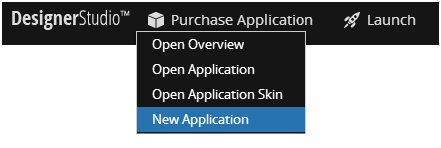Organization Setup superseded by New Application Wizard
Valid from Pega Version 7.1.3
The Organization Setup Wizard has been retired in PRPC 7.1.3. This feature was previously launched from the Designer Studio > Org & Security > Organization > Organization Setup menu. Users are encouraged to run the New Application Wizard (also known as Application Express) instead:

This tool quickly generates an application along with all of the artifacts previously offered by the Organization Setup Wizard. This includes, but is not limited to, the class hierarchy, application rule, organization/division/unit rules, and all relevant data instances.
See the following PDN article for more details on the New Application Wizard:
Create new applications quickly and easily with Application Express
DCO
Valid from Pega Version 7.1.3
In this release, specification support in Case Designer was improved. Also, improvements and fixes were made to the New Application Wizard.
- Changes were made to support a split schema environment
- Shared and Component RuleSets can be copied.
- Can edit in Word from either Grids or Lists.
- More than 50 case types are now supported for an application.
Updated Word merge support with Microsoft Silverlight plug-in
Valid from Pega Version 7.1.3
Starting in this release, Pega 7 features that integrate with the Word merge capability are now cross-browser. ActiveX controls (which are only compatible with Internet Explorer) have been replaced with Microsoft Silverlight. This plug-in must be downloaded separately from Microsoft because it is not shipped with Pega 7.
Common features that are affected by this change include the Specification form and Case Type landing page.
Prior to using these features, see the release note Word merge support with Microsoft Silverlight plug-in for more information about setting up their client systems.
Support for multiple custom mobile apps for a Pega Platform application
Valid from Pega Version 8.1
To enhance the user experience and provide support for native mobile components, you can create multiple custom mobile apps for a Pega Platform™ application. For each custom mobile app, you must create a different mobile channel interface. In addition, you can configure each custom mobile app to run only in a specific portal for an application. The custom mobile app uses this portal regardless of which default portal is defined for the access group.
For more information, see Selecting a portal for a custom mobile app.
Changes in large data page support in offline-enabled custom mobile apps
Valid from Pega Version 8.1
You can now create offline-enabled custom mobile apps that store reference data in large data pages that are sourced from report definitions, even if these report definitions return no records. Synchronization of these custom mobile apps does not fail. Also, you can now use page type properties as large data page properties.
For more information, see Creating and sourcing large data pages to store large reference data in offline-enabled applications and Custom populator JavaScript functions for large data pages.
Troubleshooting offline-enabled applications in a browser
Valid from Pega Version 8.1
You can now troubleshoot offline-enabled applications by using the Tracer tool and developer tools that are available in a web browser. You can troubleshoot scripts that are running when the application is running, without having to use additional debugging tools.
For more information, see Application debugging using the Tracer tool, Troubleshooting offline-enabled applications with the Tracer tool in a browser, and Offline capability.
Support for native search in custom mobile apps
Valid from Pega Version 8.1
To improve the overall user experience in a custom mobile app, you can configure native search in the user interface of the application. To use the search capability, first configure the pySearchConfiguration rule. This rule allows you to optionally define a set of search categories as a local data source. You then configure the mobile search action for any user interface control, for example, a button in a section. Users can tap the search field to see the most recent search results, including results that are grouped by categories, as they enter search text.
For more information, see Native search capability in custom mobile apps and Configuring search in custom mobile apps.
Enhanced Pulse performance and layout on mobile devices
Valid from Pega Version 8.1
Pulse performance is now faster on mobile devices. The user interface has been enhanced to enable better collaboration among users. The new Pulse mobile layout provides a better user experience for posting messages, adding attachments, bookmarking content, and so on.
For more information about Pulse, see:
- App Studio – Communicating with users by using Pulse
- Dev Studio – Communicating with users by using Pulse
Support for when rule in offline-enabled applications
Valid from Pega Version 8.1
You can use when rules in offline-enabled applications without creating custom JavaScript code. Using when rules reduces the offline-enabled application implementation time by further automating case processing in offline mode and deriving the logic directly from the model. No additional configuration is required to use when rules in offline mode.
For more information, see When rule support in offline mode.
Configuring geolocation tracking at the case level
Valid from Pega Version 8.1
You can now enable geolocation tracking at a case level to track users of an offline-enabled custom mobile app. By tracking users who are working on a case, you can monitor or supervise them while they are using the custom mobile app and when the app is running in the background. You can also track users when the device is not connected to the server. Recorded locations are synchronized with the server and stored in a database that is available through a data page. When Pega Platform™ receives location data, the new Map control can display multiple user tracks and markers that represent other data, for example, job locations that are assigned to users.
For more information, see Tracking mobile end users with the Map control and Adding the map control.

